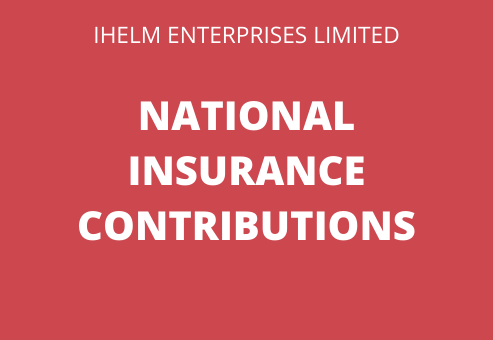During the September 2021 Facebook Live, I spoke about National Insurance Contributions – what they are, how much you have to pay and when.
The rates mentioned through this blog post are the rates that are for the tax year 06/04/2021 to 05/04/2022 unless otherwise stated.
What are National Insurance Contributions?
National Insurance Contributions (or NICs) are a tax that is paid by the worker, and by the employer, to the government which helps to pay for some state benefits when individuals need help. For example, state pensions, statutory sick pay or maternity leave. Everyone over the age of 16 pays mandatory National Insurance if they are either an employee earning more than £184 per week, or self-employed and have a profit equal to or greater than £6,515 per year. If you are an employee and earn between £120 and £184 per week, you receive a National Insurance credit without having to pay the contribution.
People can voluntarily pay NICs to help avoid gaps in their contributions. If you don’t have enough NI credits, you may not be able to get the full State Pension. You can read more about voluntary contributions on the HMRC website.
In order to pay National Insurance Contributions and receive the NI credits, you must have a National Insurance number. It is normally sent to you automatically within 3 months of your 16th birthday if you live in the UK and a parent has filled out a Child Benefit form for you. However, you can apply for an NI number if you don’t have one.
There are different types of classes of NICs, and the type you pay depends on your employment status and how much you earn.
| Class | Description |
| Class 1 NICs | Paid by employees who are earning more than £184/week and are under the State Pension Age. These are automatically deducted from your wages by the employer and paid on your behalf to HMRC. |
| Class 1A or 1B NICs | Paid by employers on any employee expenses or benefits and paid directly to HMRC. |
| Class 2 NICs | Paid by self-employed business owners who earn £6,515 or more in profits for the year. |
| Class 3 NICs | Voluntary contributions that you can pay to fill or avoid gaps in your National Insurance Record. |
| Class 4 NICs | Paid by self-employed business owners who earn £9,568 or more in profits for the year. |
Not all contributions count towards the same types of benefits.
Class 4 NICs do not usually count towards any of the state benefits.
Class 1, Class 2 and Class 3 contributions all count towards the basic state pension and the new state pension.
Class 1 and Class 2 contributions count towards contribution-based employment and support allowance, maternity allowance and bereavement support payments.
Class 1 contributions count towards the additional state pension and contribution-based jobseeker’s allowance
How much will I have to pay in NI Contributions?
From April 6th, 2022 to April 5th, 2023 all Class 1, Class 4 and secondary Class 1, 1A and 1B NICs will increase by 1.25%. Those who are over the State Pension age will not be affected. This is an increase that was announced on September 8th, 2021 by the Government and is being used to pay for the NHS and Social Care. From April 6th, 2023 it will be moved to a separate tax and will be shown as the “Health and Social Care Levy”.
Class 1 National Insurance Contributions:
- If you are earning between £184/ week and £967/week (£797/month to £4189/month) you would pay 12%
- If you are earning over £967/week (£4189/month) you would pay 2%
You might pay less in NICs if you are a married woman or widow with a valid “certificate of election” or you are deferring NI because you’ve got more than one job.
Employers pay NI Contributions depending on the employees’ category letters. The category letter is not related to a person’s National Insurance Number – but are used to determine the NI liability of the company and the employee.
| Letter | Description |
| A | This is the default category for employees if they do not fall under any other category and the standard rate of NI is paid. |
| M | This is for employees under the age of 21 and means the Employer NICs are reduced or there aren’t any. |
| C | This is for employees who are over the state pension age and they would not have any employee contributions. |
| H | This is for apprentices under the age of 25 who are following an approved apprentice framework and the Employer NICs would be nil or reduced. |
| J | This is for employees who are deferring their NI because they are paying it in another job. |
| Z | This is for employees under the age of 21 who are deferring it because they are paying it in another job. |
| B | This is for married women and widows entities to pay reduced NI. It is quite a complex category and is rarely used. |
| X | This is for employees who don’t pay any NI – for example, anyone under the age of 16. |
Class 2 and Class 4 National Insurance Contributions:
These are both based on the profits of the business. If your profits are £6,515 or more a year, you would simply pay Class 2 NICs. If your profits are £9,568 or more a year, you would also pay Class 4 NICs.
Class 2 NICs are calculated at £3.05/week and are a set rate.
Class 4 NICs are a percentage based on your profits – if you earn between £9,568 and £50,270 you would pay 9% of your profits for NICs and for any profit over £50,270 it would be 2%.
How do I pay my National Insurance Contributions?
If you are employed, your NICs are deducted from your pay and paid to HMRC on your behalf by the employer. The employer will also pay the Employer NI contributions. These figures will be shown on your payslip so that you know how much the contributions were.
If you are self-employed, the NI Contributions you pay will be calculated at the time you submit your self-assessment tax return. However, you can get an idea of whether you will need to pay Class 2 if you keep your accounts up to date on a regular monthly basis, as you will be able to see what your profit is for the year, so if you can see that your profit for the year is £6,516 or more, you know that you will need to pay £3.05 per week for 52 weeks which is £158.60.
If you are both employed and self-employed, the Class 1 NI contributions will be deducted from your wages and the Class 2 and 4 NI Contributions on your self-employed work.
There are different rules for directors, landlords and share fishermen – but you can find information about how National Insurance is calculated for those particular sectors by going to the HMRC website.
If you aren’t sure whether you have enough National Insurance Credits to receive the State Pension or want to ensure you don’t have any gaps in your National Insurance record, you can check it online.
If you have any questions about National Insurance Contributions, feel free to e-mail me and I will get back to you!

